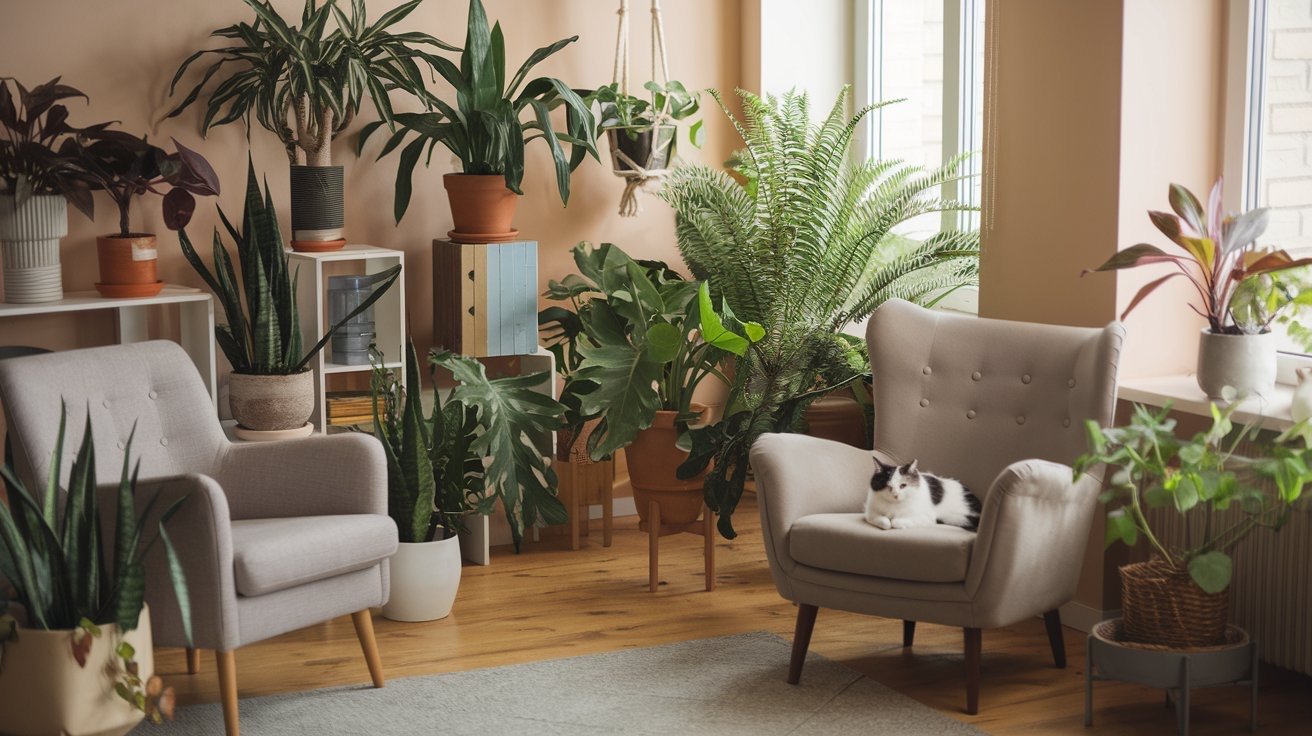
Cat-safe plants, when it comes to creating a vibrant and cozy home ith, houseplants are a must-have. They add life, color, and even health benefits to your living space. However, if you’re a cat owner, it’s crucial to choose plants that are safe for your feline friends. Some popular houseplants can be toxic to cats, leading to serious health issues if ingested. This guide will help you select cat-safe houseplants so you can keep your home green and your pets healthy.
Why Choosing Cat-Safe Plants is Important
Cats are naturally curious creatures. They love to explore, climb, and yes—nibble on things. Unfortunately, many common houseplants can be toxic to cats, causing symptoms ranging from mild irritation to severe illness. Some of the most dangerous plants include lilies, aloe vera, and philodendrons. Therefore, opting for cat-safe plants is essential for a pet-friendly home.
Top 10 Cat-Safe Houseplants
- Spider Plant (Chlorophytum comosum)
The Spider Plant is not only easy to care for but also completely non-toxic to cats. Its long, arching leaves are attractive and can even provide a bit of entertainment for your feline friend. - Boston Fern (Nephrolepis exaltata)
Boston Ferns are lush and green, perfect for adding a touch of nature to your home. They thrive in humid environments and are safe for cats to be around. - Areca Palm (Dypsis lutescens)
Also known as the Butterfly Palm, the Areca Palm is a pet-friendly plant that brings a tropical feel to any room. It’s a great choice if you’re looking for a larger plant that won’t harm your cat. - Calathea (Calathea spp.)
Calathea plants are known for their striking, colorful leaves. These plants prefer indirect light and high humidity, making them perfect for bathrooms or other humid spaces. - Catnip (Nepeta cataria)
Catnip is a must-have for any cat owner. Not only is it safe, but it also provides entertainment for your cat. Just be prepared for a bit of feline excitement! - Bamboo Palm (Chamaedorea seifrizii)
Bamboo Palms are another tropical option that is safe for cats. They grow tall and can serve as a beautiful indoor tree, adding height and greenery to your space. - African Violet (Saintpaulia)
If you prefer flowering plants, African Violets are an excellent choice. These small, colorful plants are safe for cats and thrive in indoor environments. - Parlor Palm (Chamaedorea elegans)
Parlor Palms are low-maintenance and non-toxic to cats. They grow slowly and are ideal for small spaces, making them a popular choice for apartments. - Peperomia (Peperomia spp.)
Peperomias come in a variety of shapes and sizes, all of which are safe for cats. These plants are easy to care for and do well in low to medium light. - Ponytail Palm (Beaucarnea recurvata)
Despite its name, the Ponytail Palm is actually a succulent. It’s a unique, pet-friendly plant with a bulbous base and long, curly leaves that can add a whimsical touch to your home.
Tips for Keeping Your Plants and Cats Happy
- Placement Matters
Even though these plants are safe for cats, it’s still a good idea to place them out of reach if possible. This will help prevent your cat from digging in the soil or tipping over the pots. - Monitor Plant Health
Healthy plants are less likely to drop leaves or flowers, which your cat might be tempted to play with or chew. Regularly check your plants for any signs of distress, such as yellowing leaves or wilting, and address these issues promptly.3. Provide Alternative Distractions
Cats often chew on plants out of boredom or curiosity. To keep them away from your greenery, make sure they have plenty of toys, scratching posts, and interactive playtime. You can also grow cat grass or place a pot of catnip in an accessible area to satisfy their nibbling urges.
4. Create a Cat-Friendly Green Space
Consider dedicating a specific area of your home to both your plants and your cat. You can create a mini indoor garden with a mix of cat-safe plants and a cozy spot for your cat to relax. This could include a sunny windowsill with a few potted plants and a soft bed where your cat can lounge and watch the outside world.
5. Regularly Refresh Soil and Clean Leaves
Cats might be attracted to the smell of the soil or the texture of plant leaves. Regularly refreshing the soil and wiping down the leaves can help deter them from getting too curious. Make sure to use non-toxic, organic soil and fertilizers.
Conclusion
Decorating your home with plants doesn’t have to be a hazard to your cats. By choosing cat-safe houseplants, you can enjoy a lush, green environment without worrying about your feline friend’s safety. Remember to keep an eye on your cat’s behavior around new plants and always consult your veterinarian if you’re unsure whether a particular plant is safe.
With a little planning and the right selection of plants, you can create a beautiful, pet-friendly home where both you and your cat can thrive.
